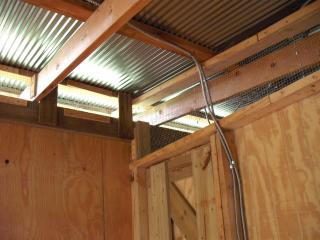- Mar 4, 2011
- 958
- 16
- 123
We're hoping to finish our coop and run over this coming log weekend, and I am trying to get everything straight before we get going, (or have to go back and redo things we did wrong
 ) I have a few questions to start...
) I have a few questions to start...
If the run connects to the face of the coop, and hardware cloth is buried around both, we are using galvanized steel fencing (the kind that makes a rectangle pattern?) with a 2x2 top rail, and covering the entire thing with aviary netting.... Do we need a door on the coop right away? We are converting the old horse barn into the coop, and it has not had a door on it. We're planning on getting one on before fall, but do the chickens need to be shut tight in the coop at night, or can they have access to the run?
Also, since there has not been a door on the barn, once there is a door, there won't be any proper ventilation. We live in Michigan. It gets hot, but generally not blazing hot, and certainly not at night when they would be shut in. We are planning on getting windows in for light before winter as we get goat loads of snow and it's unlikely they will be able to leave the coop for much of it, (It's a pretty big and tall coop, though,) but do they need to be in right away? Or a roof vent? A roof vent may be easier to accomplish over 3 days with everything else, but reading through, it looked like a lot of the people talking ventilation lived in pretty hot locations. The coop is in a fair amount of shade, but the sides, front, and roof are metal. The main back wall is wood.
Should I mow the area over before putting the chickens in? It's not lawn, it is mostly fertile dirt (well... it is old horse pasture...) in a semi wooded area with some foliage. I'm mean, not wading through a jungle, but I though it might be easier on the chickens if I shortened things a bit. My husband didn't think it was worth bothering. I really don't know, but it wouldn't take but a few minutes to go over with the mower if that would be nicer for them. I haven't taken a picture since it was covered in snow, or I'd post one.

Lastly, the coop has a wooden structure, but the metal siding doesn't quite meet at the corners or in some places where the roof meets the walls. We will pound them together, but I'm worried that won't be enough. Should I try to put corners on, somehow? Or, we are planning to insulate the coop before winter, could I pound them together and fill any gaps with "Great Stuff" which will eventually get covered over with insulation and plywood?
Any other thoughts or tips for a newb would also be appreciated, thanks


If the run connects to the face of the coop, and hardware cloth is buried around both, we are using galvanized steel fencing (the kind that makes a rectangle pattern?) with a 2x2 top rail, and covering the entire thing with aviary netting.... Do we need a door on the coop right away? We are converting the old horse barn into the coop, and it has not had a door on it. We're planning on getting one on before fall, but do the chickens need to be shut tight in the coop at night, or can they have access to the run?
Also, since there has not been a door on the barn, once there is a door, there won't be any proper ventilation. We live in Michigan. It gets hot, but generally not blazing hot, and certainly not at night when they would be shut in. We are planning on getting windows in for light before winter as we get goat loads of snow and it's unlikely they will be able to leave the coop for much of it, (It's a pretty big and tall coop, though,) but do they need to be in right away? Or a roof vent? A roof vent may be easier to accomplish over 3 days with everything else, but reading through, it looked like a lot of the people talking ventilation lived in pretty hot locations. The coop is in a fair amount of shade, but the sides, front, and roof are metal. The main back wall is wood.
Should I mow the area over before putting the chickens in? It's not lawn, it is mostly fertile dirt (well... it is old horse pasture...) in a semi wooded area with some foliage. I'm mean, not wading through a jungle, but I though it might be easier on the chickens if I shortened things a bit. My husband didn't think it was worth bothering. I really don't know, but it wouldn't take but a few minutes to go over with the mower if that would be nicer for them. I haven't taken a picture since it was covered in snow, or I'd post one.

Lastly, the coop has a wooden structure, but the metal siding doesn't quite meet at the corners or in some places where the roof meets the walls. We will pound them together, but I'm worried that won't be enough. Should I try to put corners on, somehow? Or, we are planning to insulate the coop before winter, could I pound them together and fill any gaps with "Great Stuff" which will eventually get covered over with insulation and plywood?
Any other thoughts or tips for a newb would also be appreciated, thanks







